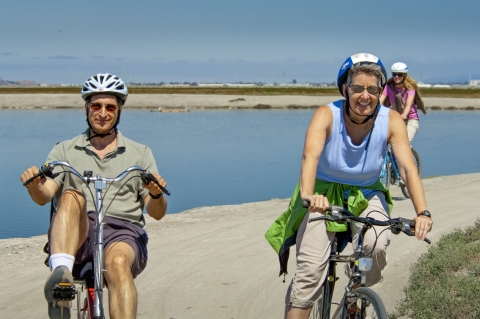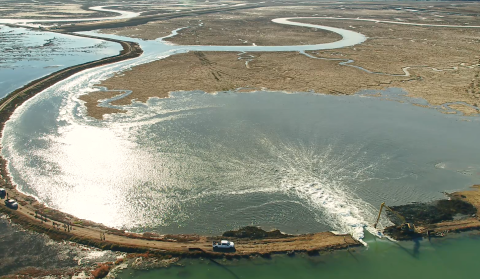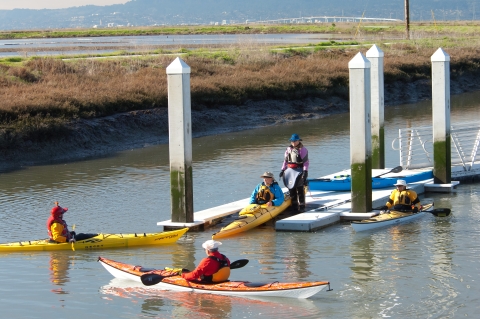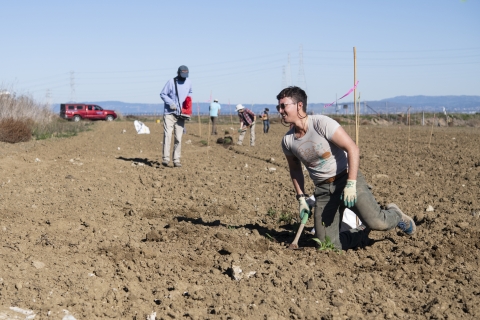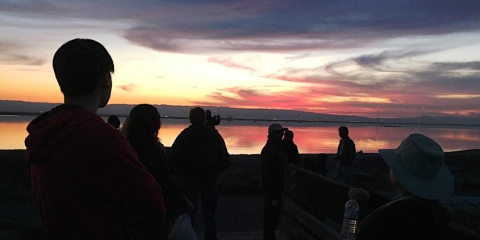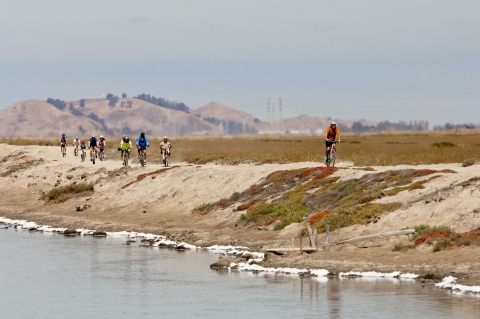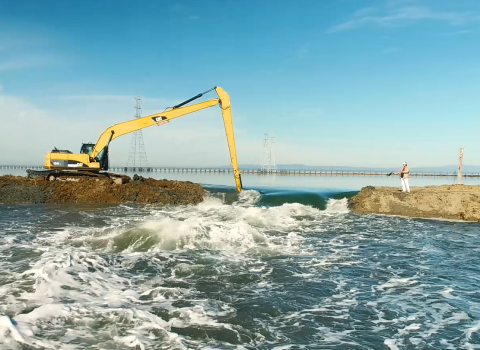Twenty years after a complex, multi-partner effort began to restore south San Francisco Bay and boost its resilience to climate change climate change
Climate change includes both global warming driven by human-induced emissions of greenhouse gases and the resulting large-scale shifts in weather patterns. Though there have been previous periods of climatic change, since the mid-20th century humans have had an unprecedented impact on Earth's climate system and caused change on a global scale.
Learn more about climate change , some benefits to wildlife and people are growing easier see.
Tidal flow has returned to more than 3,000 marsh acres — some of them visible from new trails and overlooks. Migratory waterbirds such as northern shovelers and canvasbacks are thriving in native pickleweed and cordgrasss. Public recreation access is improving.
That’s welcome news at Don Edwards San Francisco Bay National Wildlife Refuge, a peerless natural resource in this region of 8 million people and the largest landholder along the bay's edge. The refuge is managed by the U.S. Fish and Wildlife Service — a key player in South Bay Salt Pond Restoration Project, returning salt ponds to marshlands. Two of three project sites are in the refuge; the other is a state ecological reserve. Together they account for the West Coast’s largest tidal wetland restoration.
That’s a source of considerable pride for Matt Brown, manager of the San Francisco Bay National Wildlife Refuge Complex. The complex covers seven refuges including San Francisco Bay Refuge.
“We’re creating habitat for some endangered species that are only found in San Francisco Bay — like the Ridgway’s rail [a rust-colored shorebird] and the salt marsh salt marsh
Salt marshes are found in tidal areas near the coast, where freshwater mixes with saltwater.
Learn more about salt marsh harvest mouse,” says Brown.
“We are opening miles of new trails to people who don’t have a lot of access to open space in this super-urban environment — these beautiful trails that go along the coast and into the marshes and give people a place of solitude and wonder. The restoration also helps protect communities against sea-level rise.”
How It Began
The plan to return 15,000 acres of industrial salt ponds on the South Bay to tidal marsh dates from 2003, when the late Senator Dianne Feinstein helped negotiate their purchase from agribusiness giant Cargill. Restoring the marsh was also meant to improve recreation access and reduce flood risk.
And none too soon.
A century and a half of urban development, pollution and habitat destruction had depleted bay habitat, “eliminating more than 90 percent of shoreline wetlands and 40 percent of the total San Francisco Bay aquatic ecosystem,” according to the Environmental Protection Agency. The loss of ecologically sensitive marshlands also meant the loss of natural storm buffers.
South Bay – directly affected by that loss -- is home to some of the region’s richest and poorest communities as well as the Silicon Valley tech campuses of Apple, Google and Meta (formerly Facebook).
Now, climate change — in the form of harsher storms and rising seas — is adding to the vulnerability of some Bay-area communities. Decades of poor urban planning haven’t helped.
“If you look at the South Bay, they built all the landfills and the wastewater treatment plants right on the shoreline,” says Brown. “So you have all these small communities that are nestled in between a landfill and a wastewater treatment plant.” In January 2023 Bay-area storms released millions of gallons of wastewater into city streets and into the bay.
The city of Alviso — surrounded by the bay, Guadalupe River and Coyote Creek — is a case study of the effects of geography and land use. In the early 20th century, orchard growers sucked dry the groundwater to feed fruit trees. The land sank to 12 feet below sea level. Meanwhile, salt producers drained bay marshes. And so, during heavy rains and high tides, there is little to stop flooding and pollution.
Project partners, who, in addition to the Service include the California State Coastal Conservancy, California Department of Fish and Wildlife, Ducks Unlimited, the Santa Clara Valley Water District, and the U.S. Army Corps of Engineers, hope restored marshes will improve the picture.
Visible Momentum
Lately, progress on the project has been hard to miss.
In mid-December 2023, project partners returned tidal flow to 300 acres of wildlife habitat at the Ravenswood unit of San Francisco Bay Refuge. Engineers reopened the marsh — which helps filter the water and absorb tidal overflow — after building sloped transition zones and improving levees to reduce flood risk to low-lying neighboring communities.
In June 2023, the Environmental Protection Agency targeted $50 million in grants to the 50-year restoration effort. Federal funding was made possible after Congress passed the San Francisco Bay Restoration Act in December 2022. (State funding began in 2020 after California voters approved a tax adding $8 million to the project over 20 years.)
In spring 2024, the Service plans to open a new half-mile connector recreation trail at Ravenswood. That will make 7 ½ new miles of trail that the South Bay project has created to date for area residents, on top of the 30-plus miles already in existence at San Francisco Bay Refuge. Other recreational enhancements tied to the project include a kayak launch, added on state lands, along with new viewing and interpretive areas.
Deputy San Francisco Bay Refuge Complex manager Chris Barr hopes the rest of the country takes note. "We want to elevate the San Francisco Bay restoration to the same level [in public awareness] as the Chesapeake Bay restoration and the Great Lakes restoration," he says.
Clearing Hurdles
But plenty of project challenges remain.
A shortage of clean dirt — or fill — is one. Raising sunken marshes requires hundreds of thousands of cubic yards of fill, free of toxic metals such as mercury and cadmium, says Dave Halsing, executive project manager for the restoration. Construction firms have been donating fill but the timing, volume and cleanliness of the donations vary and are hard to predict.
Getting the go-ahead to dredge, say, breach levees, or route construction crews through local roads is more than the usual headache. National wildlife refuges must consult neighboring landowners before moving earth. Here, those landowners include cities and utilities. “It’s hard doing work in an urban environment,” says Halsing. “Refuge lands here can bump right up against wastewater treatment plants or a Pacific Gas & Electric substation.”
Working in wildlife habitat adds additional hurdles: the need for environmental reviews and sensitivity to breeding seasons. Biologists need to control non-native grasses, like invasive spartina. Also, project managers don’t want to eliminate all salt ponds. Some shorebirds such as gulls, grebes and terns favor salt flats and salt ponds rich in brine shrimp, a major food source.
Then there is the weather. Even in a normal winter, rains can stop marsh work. The winter of 2022-23 was anything but normal. The Ravenswood breach was postponed 12 months after an “atmospheric river” dumped more than 17 inches of rain on San Francisco between December 26, 2022 and January 17, 2023.
Population growth, climate change and habitat loss add to project complexities.
Rooted in Community
But there is also plenty that is right with the South Bay restoration, refuge leaders say.
Behind the project’s success is a commitment to shared decision-making and transparency, says deputy complex manager Chris Barr.
“What makes this project special to me is that it was community grown, community based,” says Barr. Community members include citizens groups, tribes, corporate interests, environmentalists and others. The many project partners share a commitment to transparency, working to keep all involved and up to date on project planning.
“We have stakeholder groups, public meetings to keep the public aware,” says Barr. “We have a robust website where they can see all public documents they helped shape in public meetings. We’re very robust in sharing out the science, the planning and getting community input.”
All the more reason for pride in the South Bay restoration’s progress, says Matt Brown, manager of the San Francisco Bay Refuge Complex.
“In a world where so many things are slipping in the wrong direction — like population trends of all these species is going down, and the world is becoming hotter, and storms are becoming more violent — what we’re doing in San Francisco Bay is we’re moving the needle in the other direction,” says Brown.
“We’re providing new opportunities for people. We’re providing new habitat. We are healing San Francisco Bay, righting some of humanity’s wrongs.”
